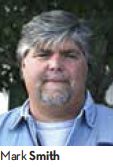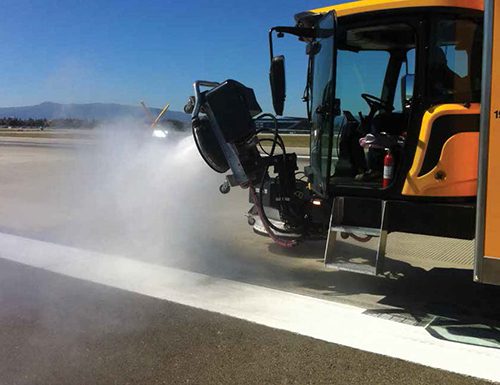Removing rubber from runways is a significant maintenance expense at most big-city airports. As such, facility operators are continually debating the relative merits of outsourcing the job or investing in personnel and equipment to handle the ongoing task in-house. Given the cost and safety-sensitive nature of the work, it’s a pivotal decision.
Norman Y. Mineta San Jose International (SJC), in California’s Silicon Valley, recently moved its quarterly rubber removal operations in-house; and airport officials are pleased with the change. SJC employees have been using a rubber removal machine the airport purchased at the beginning of the year.
“It has already made a big difference in our rubber removal operation,” reports Mark Smith, airport maintenance supervisor at SJC, with Cyclone supplying the curriculum material and “factory experts” to help present it.
 factsfigures factsfiguresProject: Rubber Removal Location: Mineta San Jose (CA) Int’l Airport Runways: 2 north/south pavements, each 11,000 ft. long Strategy Change: Complete work with in-house vs. using outside contractor Equipment Purchased: Cyclone 4006 AC Manufacturer: Nilfisk-Advance Technologies Equipment Distributor: Team Eagle Approx. Cost: $619,000 Est. Break-Even Point: 31/2 yrs. Key Benefits: Greater scheduling flexibility; lower long-term runway maintenance costs; reduced water & fuel consumption; new equipment can also remove paint |
Previously, the airport hired an outside contractor to remove rubber from its two 11,000-foot runways and perform friction tests before and after to document the results. Typically, SJC awarded three-year contracts with two-year options. Eventually, outsourcing became a less attractive strategy, due to the limited number of rubber removal contractors that are available. “They were often so busy, they occasionally had to drive all night to get here,” Smith recalls. “It was sometimes challenging to get everything done on time.”
Frequent equipment failures and associated schedule delays were other drawbacks to working with an outside service company, he adds.
As a result, SJC decided to take the airfield maintenance matter into its own hands. Last fall, the airport requested proposals from three different equipment manufacturers. In January, it purchased a Cyclone 4006 AC, manufactured by Nilfisk-Advance Technologies.
Smith considers the $619,000 vehicle an excellent long-term investment for the airport. “It should pay for itself in only 31/2 years,” he reports. “And we expect it to last a good 10 to 15 years.”
Equipped for the Job
The machine’s self-contained design was a key factor for Smith and his employees. “You don’t have to tow a vacuum unit behind it,” he relates. “With the Cyclone, blades under the head produce lift. Ultra-high-pressure water scours and lifts the rubber, which is ground up within the truck itself, somewhat like a garbage disposal.”
The machine is designed to cover about 20,000 square feet per hour. Crews typically run the equipment from 11 p.m. to 5 a.m., when the control tower is not in operation. (Last year, SJC logged 128,000 aircraft operations. Daily traffic includes both commercial and general aviation traffic.)
“The south ends of both runways are the main touchdown areas, so we try to concentrate the rubber removal on 3,500- to 4,000-foot sections at those ends,” Smith explains.
Airfield maintenance employees at the airport rank visibility from the truck’s cab as excellent. “Big windows in front and along the side offer almost a 180-degree view,” remarks Smith. “You get a huge, clear view of what you are doing, and three on-board cameras also help viewing.”
Because most of SJC’s rubber removal is performed at night, lighting was another important selection criterion. After operating the vehicle for nearly one year, airport employees give the Cyclone top marks for illumination. “It lights up like a Christmas tree,” says Smith.
Like all major airports in California, SJC faces strict state environmental standards. Airport personnel consequently pay close attention to “green” factors and performance characteristics when selecting new equipment. While some rubber removal machines use 10 to 12 gallons of water per minute, the Cyclone uses 6 gallons per minute. It also filters water with a 0.35-micron filter, notes Smith.
 The city of San Jose imposes air quality regulations on the airport, including a provision that requires it to use airfield equipment that burns biodiesel fuel. SJC’s new Cyclone is powered by a John Deere 9.0L Tier 4 375hp diesel engine, which meets city emission standards.
The city of San Jose imposes air quality regulations on the airport, including a provision that requires it to use airfield equipment that burns biodiesel fuel. SJC’s new Cyclone is powered by a John Deere 9.0L Tier 4 375hp diesel engine, which meets city emission standards.
New Staff Skills
Training was another factor that swayed SJC toward the Cyclone. “We wanted to be sure that our maintenance staff not only learned how to use the machine properly, but could do all normal maintenance and service tasks right here at the airport,” Smith remarks.
Team Eagle, the North American distributor of Cyclone, provided the equipment training at SJC. “When an airport buys a new machine from us, we send our trainers to the facility for up to a week,” says Bill Crow, the company’s southwestern U.S. territory manager. “These machines are very sophisticated, computer-controlled systems with pressures up to 40,000 psi. Operators must know how and when to adjust pressures and speeds for the different surfaces and conditions. This comes with experience.”
At busy airports like SJC, Team Eagle and Cyclone often perform the bulk of training on remote taxiways or ramps. (SJC averages 125 commercial and 85 general aviation departures daily.)
“Eventually, we often do take trainees out on a runway, usually at night,” Crow comments. “It is important that they get out there ‘where the rubber meets the road.'”
He suspects that experienced operators typically don’t struggle with the training because the Cyclone 4006 AC is very intuitive to operate. “They pick it up fairly quickly; everything makes sense. But you have to get out there and do it,” he emphasizes.
Crow strongly encourages airports to train a relatively small number of staff members. Following his advice, SJC designated three people to learn how to use and maintain the airport’s new truck: two main drivers and a reserve employee. “We only had a few days with the Team Eagle trainers, and this is a very technical machine,” Smith explains.
Employees have only encountered a few minor problems since the airport purchased the removal machine at the beginning of the year. “With every piece of new equipment there are always glitches during the break-in period,” comments Smith. “We had a couple of hydraulic leaks. Also, a starwheel motor component was faulty; but this was a recall item that the company corrected immediately. Other than that, we only had to replace water nozzles, which is easy. These, and most other components on the Cyclone 4006, can be repaired in the field within minutes.”
The new truck recently scored bonus points with airport officials by serving double duty. This summer, crews used the Cyclone to remove paint from one of SJC’s main runways while it was closed for repairs. “It worked quite well,” Smith reports.
Above all, the new machine has given the airfield maintenance staff more flexibility. “Instead of having a very rigid schedule of rubber removal, we can do it at our convenience,” he reflects. “And if something needs touching up, we can do that right away – without worrying about getting the outside contractor in.”




